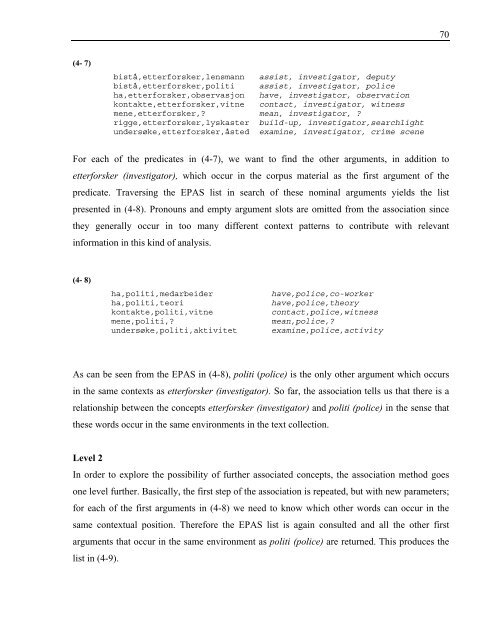Unni Cathrine Eiken February 2005
Unni Cathrine Eiken February 2005
Unni Cathrine Eiken February 2005
You also want an ePaper? Increase the reach of your titles
YUMPU automatically turns print PDFs into web optimized ePapers that Google loves.
(4- 7)<br />
bistå,etterforsker,lensmann<br />
bistå,etterforsker,politi<br />
ha,etterforsker,observasjon<br />
kontakte,etterforsker,vitne<br />
mene,etterforsker,?<br />
rigge,etterforsker,lyskaster<br />
undersøke,etterforsker,åsted<br />
assist, investigator, deputy<br />
assist, investigator, police<br />
have, investigator, observation<br />
contact, investigator, witness<br />
mean, investigator, ?<br />
build-up, investigator,searchlight<br />
examine, investigator, crime scene<br />
For each of the predicates in (4-7), we want to find the other arguments, in addition to<br />
etterforsker (investigator), which occur in the corpus material as the first argument of the<br />
predicate. Traversing the EPAS list in search of these nominal arguments yields the list<br />
presented in (4-8). Pronouns and empty argument slots are omitted from the association since<br />
they generally occur in too many different context patterns to contribute with relevant<br />
information in this kind of analysis.<br />
(4- 8)<br />
ha,politi,medarbeider<br />
ha,politi,teori<br />
kontakte,politi,vitne<br />
mene,politi,?<br />
undersøke,politi,aktivitet<br />
have,police,co-worker<br />
have,police,theory<br />
contact,police,witness<br />
mean,police,?<br />
examine,police,activity<br />
As can be seen from the EPAS in (4-8), politi (police) is the only other argument which occurs<br />
in the same contexts as etterforsker (investigator). So far, the association tells us that there is a<br />
relationship between the concepts etterforsker (investigator) and politi (police) in the sense that<br />
these words occur in the same environments in the text collection.<br />
Level 2<br />
In order to explore the possibility of further associated concepts, the association method goes<br />
one level further. Basically, the first step of the association is repeated, but with new parameters;<br />
for each of the first arguments in (4-8) we need to know which other words can occur in the<br />
same contextual position. Therefore the EPAS list is again consulted and all the other first<br />
arguments that occur in the same environment as politi (police) are returned. This produces the<br />
list in (4-9).<br />
70

















